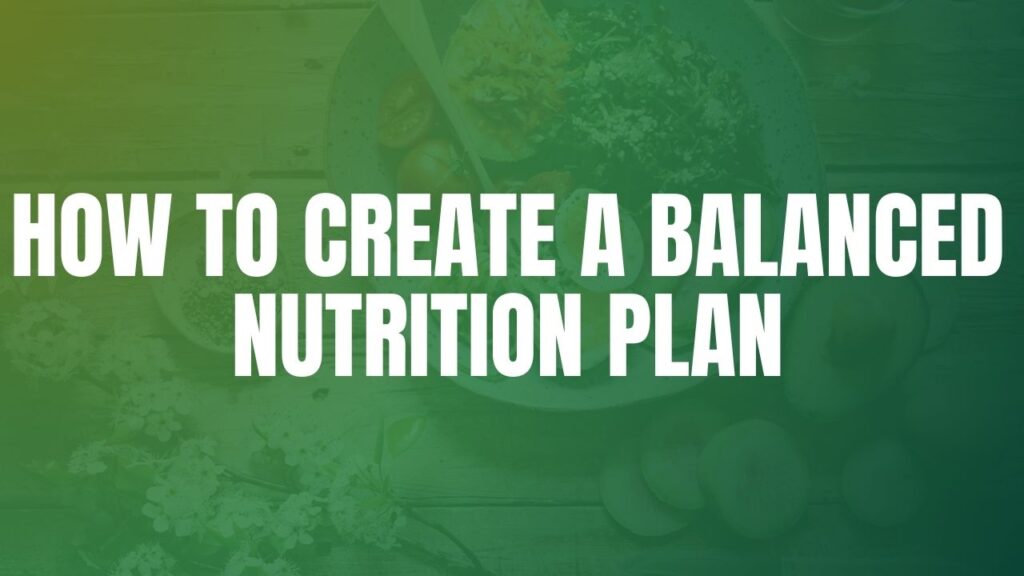How to Create a Balanced Nutrition Plan

A balanced nutrition plan is essential for maintaining good health, optimal energy levels, and overall well-being. Whether you want to lose weight, build muscle, or simply eat healthier, this guide will help you create a sustainable and effective nutrition plan that fits your goals and lifestyle.
Understanding a Balanced Diet
A balanced diet provides your body with the essential nutrients it needs to function properly. This includes:
🔹 Macronutrients (Energy Providers)
- Proteins 🥩 (Chicken, fish, tofu) – Essential for muscle repair and growth.
- Carbohydrates 🍞 (Whole grains, fruits, legumes) – The body’s main energy source.
- Fats 🥑 (Nuts, olive oil, fatty fish) – Supports brain health and hormone production.
🔹 Micronutrients (Essential Vitamins & Minerals)
- Vitamins (Vitamin C, D, B-complex) – Strengthens immunity and metabolism.
- Minerals (Iron, magnesium, calcium) – Supports bone health and oxygen transport.
🔹 Hydration 💧
Water is crucial for digestion, circulation, and energy levels. Aim for at least 2 liters per day.
Setting Your Nutrition Goals
Before creating a meal plan, define your health and fitness goals:
✅ Weight Loss – Focus on a caloric deficit while maintaining protein intake.
✅ Muscle Gain – Increase protein and calorie intake with resistance training.
✅ Overall Health – Aim for balanced meals with a variety of whole foods.
💡 Use a calorie calculator to determine your daily caloric needs based on your age, weight, activity level, and goals.
Building Your Meal Plan
Step 1: Choose High-Quality Protein Sources
🔸 Lean meats (chicken, turkey, fish)
🔸 Plant-based proteins (tofu, lentils, chickpeas)
🔸 Eggs and dairy (Greek yogurt, cottage cheese)
Step 2: Select Healthy Carbohydrates
🔸 Whole grains (brown rice, quinoa, oats)
🔸 Fruits and vegetables (berries, spinach, broccoli)
🔸 Legumes (beans, lentils, chickpeas)
Step 3: Include Healthy Fats
🔸 Avocados, nuts, and seeds
🔸 Olive oil and coconut oil
🔸 Fatty fish (salmon, sardines, mackerel)
Step 4: Plan Balanced Meals
| Meal | Example |
|---|---|
| Breakfast | Scrambled eggs + whole wheat toast + avocado |
| Lunch | Grilled chicken + quinoa + steamed veggies |
| Dinner | Baked salmon + brown rice + spinach salad |
| Snack | Greek yogurt + almonds + berries |
💡 Tip: Use the "Plate Method" – Fill half your plate with veggies, one-quarter with protein, and one-quarter with whole grains.
Portion Control & Meal Timing
🍽️ Key Tips:
✔️ Eat smaller meals throughout the day to maintain energy.
✔️ Avoid overeating by using portioned plates or measuring food.
✔️ Listen to your hunger cues – Eat when you’re hungry, stop when satisfied.
✔️ Stay consistent – Meal prep to avoid unhealthy choices.
Hydration & Supplementation
💧 Water Intake: Aim for 8+ glasses per day to support digestion and metabolism.
🔹 Electrolytes: If you exercise frequently, replenish with potassium and magnesium.
🔹 Supplements: Consider vitamin D, omega-3s, and probiotics if needed.
Common Mistakes to Avoid
🚫 Skipping Meals: Leads to low energy and binge eating later.
🚫 Too Many Processed Foods: Increases sugar intake and unhealthy fats.
🚫 Not Enough Fiber: Causes digestive issues and poor gut health.
🚫 Ignoring Hydration: Dehydration slows metabolism and reduces energy.
Final Thoughts
A balanced nutrition plan is about consistency, quality food choices, and proper portions. By following these steps, you can create a sustainable diet that aligns with your health goals.
🚀 Key Takeaways:
✔️ Eat whole, unprocessed foods.
✔️ Balance proteins, carbs, and healthy fats.
✔️ Stay hydrated and eat mindfully.

Posts That May Interest You